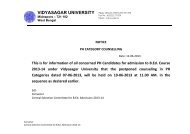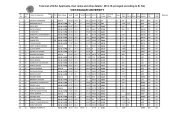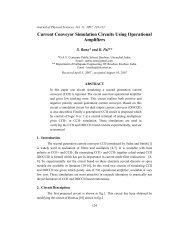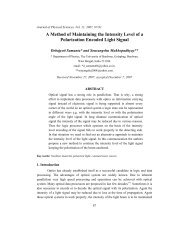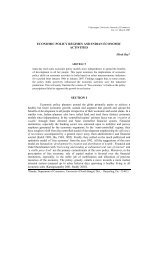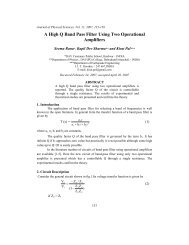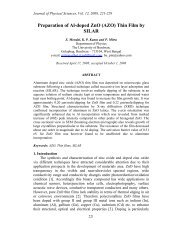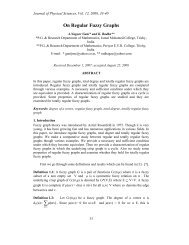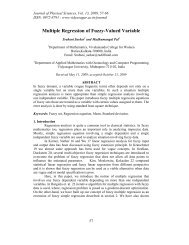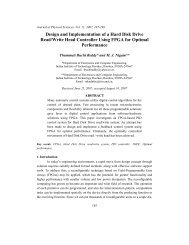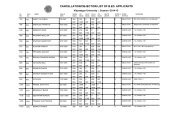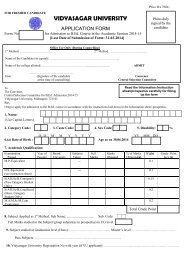VIDYASAGAR UNIVERSITY JOURNAL OF COMMERCE
VIDYASAGAR UNIVERSITY JOURNAL OF COMMERCE
VIDYASAGAR UNIVERSITY JOURNAL OF COMMERCE
You also want an ePaper? Increase the reach of your titles
YUMPU automatically turns print PDFs into web optimized ePapers that Google loves.
Arindam Gupta, Debashis Kundu<br />
Burden, on the other hand, is the difference between non-interest expense (summation of<br />
establishment expenditure, other current and non-current expenditure) and non-interest<br />
income (summation of commission, exchange, brokerage, and such other income). It can<br />
also be indicated either in absolute amount or in percentage.<br />
Burden = Non-Interest Expense – Non-Interest Income<br />
Interest yield (Yield) indicates the total earnings of the bank from advances expressed in<br />
the form of percentage.<br />
Return on Net Worth (RONW) is a profitability measure obtained by dividing net<br />
profit after tax (with adjustment of tax savings on interest) by tangible net worth.<br />
Scheme of Investigation<br />
All the variables have been either directly obtained or calculated using their standard<br />
formula since 2001, the year just prior to the merger. The year-end share price has been<br />
sourced from National Stock Exchange (NSE) and has been used to calculate the year-end<br />
market capitalization.<br />
The first part of the study highlights the effect on profitability of the company due to<br />
changes in Spread and Burden over the years. The figures are indicated in absolute amount<br />
with the growth in percentage form. The actual difference between Spread and Burden<br />
indicates the profitability of the Bank.<br />
In the second part, the percentage change from year to year in MVA and EVA highlights<br />
respectively the quantum of shareholder wealth and ‘economic’ profits created through the<br />
reverse merger process. It thus points to the extent of success of the merger from the<br />
viewpoint of the shareholder.<br />
The third part examines the degree of association between MVA with each of the other<br />
variables with the help of correlation coefficients. Pearson’s (to find the magnitude of<br />
correlation), Spearman’s (to find the ranking of the magnitudes) and Kendall’s (to find the<br />
nature of the associated changes) correlation coefficients and their appropriate statistical<br />
tests are used for this purpose.<br />
The result of these correlations may be due to simply the chance factor. In order to test for<br />
this chance factor, Runs test are performed on each of the variables. If the Runs tests prove<br />
to be significant in one-tail (since the variables are supposed to be directly related) even at<br />
5% level of significance, it indicates that the series is non-random and contains a systematic<br />
part. The systematic part may come from respective trend effects that can be eliminated with<br />
the help of a trend equation. The trend equation is fitted first with the help of three<br />
alternative trend equations, viz., linear (y = a + bt + ut), log-linear (ln y = a + bt + ut) and<br />
log-quadratic (ln y = a + bt + ct 2 + ut) [where, Y is the dependent variable and t is time]. A<br />
particular form is chosen on the basis of adjusted R 2 and the Durbin-Watson (D-W) statistic.<br />
Then the residual values of the concerned variables are calculated by deducting the expected<br />
values as per the best-fitted trend equation from the actual observed values.<br />
Now, the variables with their residual values are taken into multiple regression with other<br />
variables with their original values. Incremental regression analyses are carried out by<br />
increasing one independent variable at every stage. At first, MVA is taken as the dependent<br />
Vidyasagar University Journal of Commerce 71



